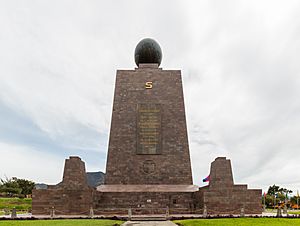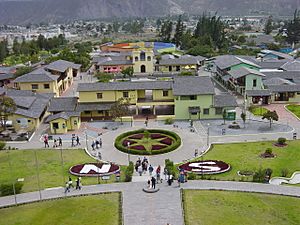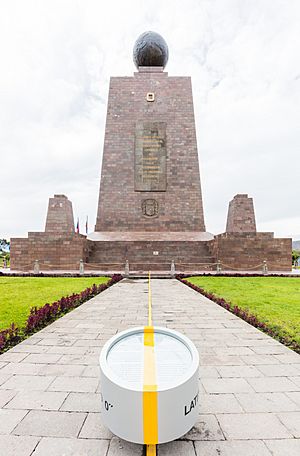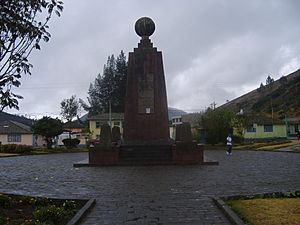Ciudad Mitad del Mundo facts for kids
Quick facts for kids Ciudad Mitad del Mundo |
|
|---|---|

The Monument to the Equator
(Monumento a la Mitad del Mundo) |
|
| Type | Museum park and monument |
| Location | San Antonio parish, Quito, Ecuador |
| Operated by | Prefecture of Pichincha |
| Status | Open all year |
The Ciudad Mitad del Mundo (which means Middle of the World City) is a special place in Ecuador. It's owned by the government of the Pichincha area. You can find it in San Antonio parish, about 26 kilometers (16 miles) north of the center of Quito, the capital city.
This amazing site has the Monument to the Equator. This monument shows the exact spot where the Equator line is. The country of Ecuador even gets its name from this important line! The monument also remembers a special trip made by French and Spanish scientists in the 1700s. They helped figure out where the Equator was.
At Ciudad Mitad del Mundo, you can also visit the Museo Etnográfico Mitad del Mundo. This museum teaches you all about the different groups of indigenous people who live in Ecuador.
The main monument is 30 meters (98 feet) tall. It was built between 1979 and 1982. It replaced an older, smaller monument from 1936. The monument is made of iron and concrete. It is covered with shiny andesite stone.
The monument celebrates the first Geodesic Mission from the French Academy of Sciences. This mission happened in 1736. Scientists like Louis Godin, Pierre Bouguer, and Charles Marie de La Condamine led the trip. They did experiments to see if the Earth was a perfect ball or a bit flat at the poles. They compared measurements from the Equator to measurements in Sweden. The older monument was moved 7 kilometers (4.3 miles) to a nearby town called Calacalí.
The former headquarters of UNASUR (a group of South American nations) was located here. However, Ecuador left the organization in 2019. So, the building is not used anymore. It's interesting to know that only two other places are exactly on the Equator nearby. These are the Catequilla archaeological site and the Quitsato Sundial.
Contents
The French Geodesic Mission and the Equator
How Scientists Found the Equator
The location of the Equator line was first studied during a trip in 1736. This trip was called the French Geodesic Mission. These studies helped scientists figure out the exact size and shape of the Earth.
However, the astronomers on this trip missed something important. They did not realize that people had already made amazing maps and measurements in this "Equatorial" area. This was done hundreds of years before they arrived!
Ancient Discoveries and Modern Corrections
While the astronomers were trying to measure the Earth, they found old ruins nearby. These ruins were built by the Quitu-Cara culture. Years later, it was discovered that the "Geodesic Mission" had made a small mistake. Their measurements showed the Earth was oblate (a bit squashed at the poles). But their exact spot for the Equator was off by about 240 meters (787 feet).
The Catequilla ruins, found during the 1735-1745 expedition, are actually at latitude 0. This is the true spot where the Equator line crosses.
In 1935, the government of Ecuador built a 10-meter (33-foot) tall monument. It honored the French expedition. A local geographer named Luis Gudiño guided this project. In 1972, that monument was replaced. The new one is 30 meters (98 feet) tall. It is the "Ciudad Mitad del Mundo" monument we see today.
The Equator Line Today
Why the Line is Different Now
For many years, people believed the Equator passed through the two monument sites. But modern GPS systems use something called the World Geodetic System WGS84. According to these new readings, the Equator is actually about 240 meters (787 feet) north of the line marked at the monument.
Even so, many tourists still love to take pictures. They stand with one foot on each side of the yellow line. This line is drawn down the center of the monument's staircase and across the plaza.
What You Can See at the Monument
The main monument is shaped like a pyramid. Each side faces a main direction (north, south, east, west). On top of the monument is a large globe. It is 4.5 meters (15 feet) wide and weighs 5 tons (11,000 pounds)!
Inside the monument, there is a small museum. It shows many interesting things about Ecuadorian culture. You can see traditional clothing and learn about different ethnic groups. You can also see examples of their daily activities.
Ciudad Mitad del Mundo has other fun things to do. There is a planetarium where you can learn about space. There is also a tiny model of the city of Quito. You can find restaurants to eat at too. On weekends, the main plaza at Ciudad Mitad del Mundo has music and cultural shows for visitors. There are also many shops selling local handmade crafts. You can try local food at several small cafes that look like an old colonial town.
Intiñan Solar Museum
About 200 meters (656 feet) northeast of the main monument is a private museum. It is called the Intiñan Solar Museum. This museum also claims to be on the Equator. However, modern measurements show it is not exactly on the line either.
Besides showing Ecuadoran culture, this museum offers some fun demonstrations. Tour guides show visitors "tricks" that are supposedly only possible on the Equator. For example, they might show water draining in different directions. They say this is because of the Coriolis force. But the Coriolis force is too weak to affect water in a small drain. It only affects very large things like ocean currents or weather systems.
Another trick is balancing eggs on their ends. They say this is easier at the Equator because of the Earth's magnetic field. But you can balance eggs anywhere on Earth with a steady hand! It has nothing to do with magnetism or the Equator. Some guides also claim muscles get weaker at the Equator. This is also not true.
Many of the demonstrations and claims at the museum are not scientifically accurate. However, some tour guides will tell you the truth. They explain that being close to the Equator does not really affect these demonstrations. It is still a fun place to visit and learn!
See also
 In Spanish: Ciudad Mitad del Mundo para niños
In Spanish: Ciudad Mitad del Mundo para niños




